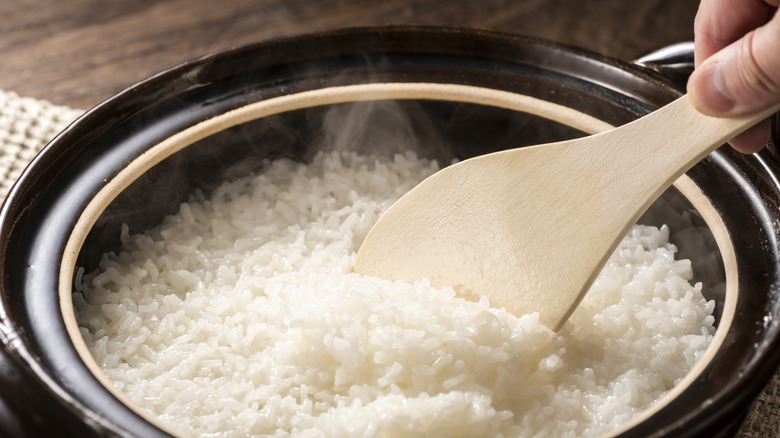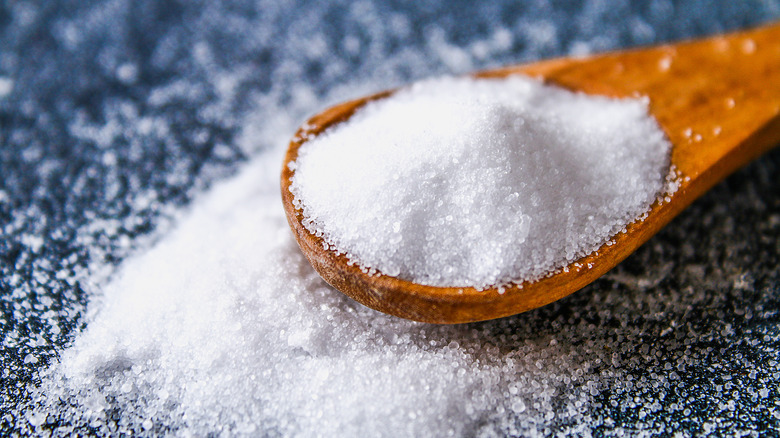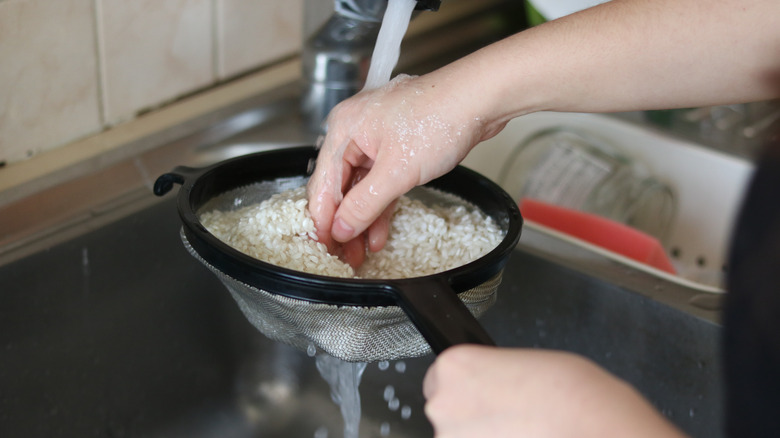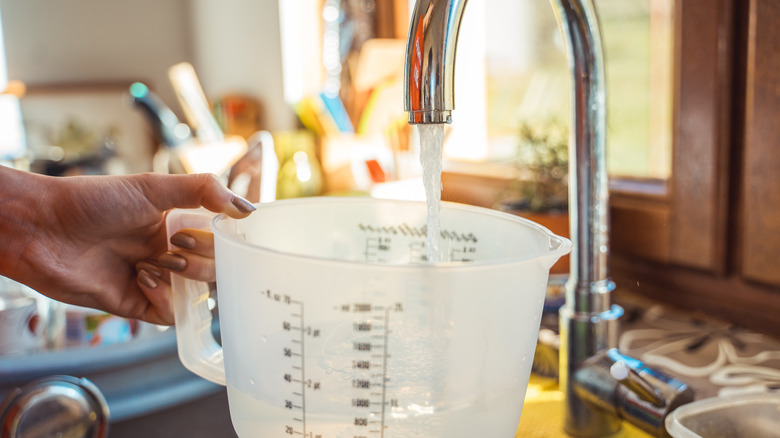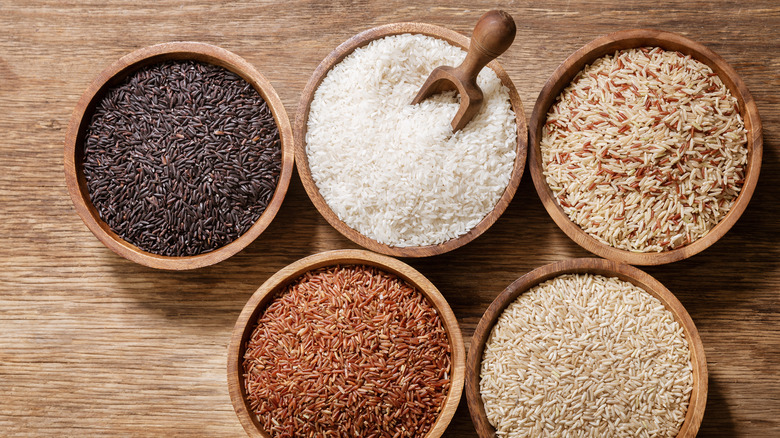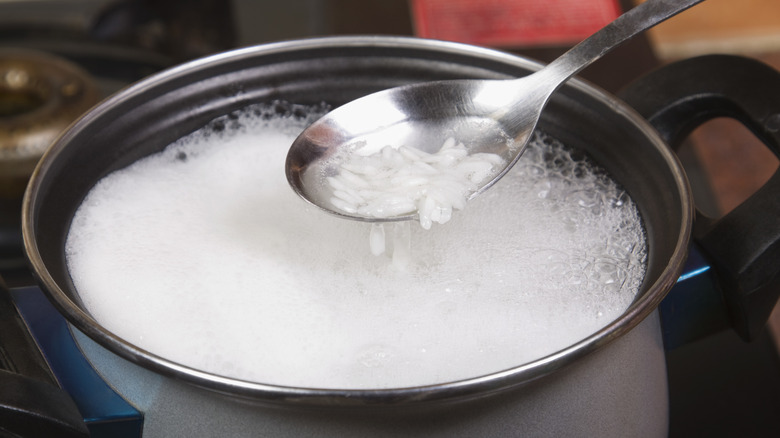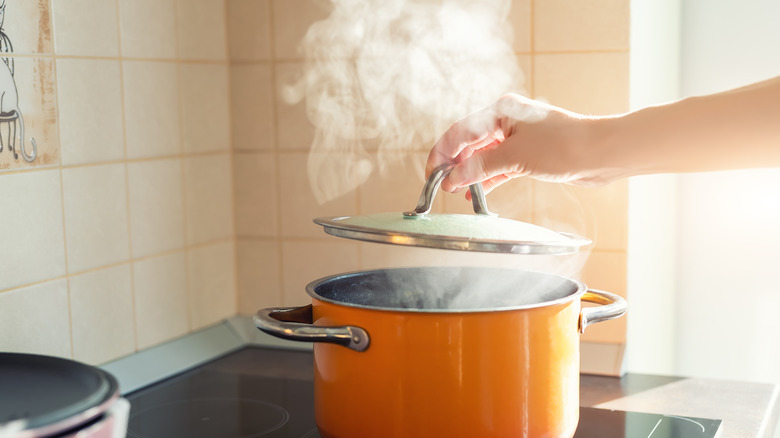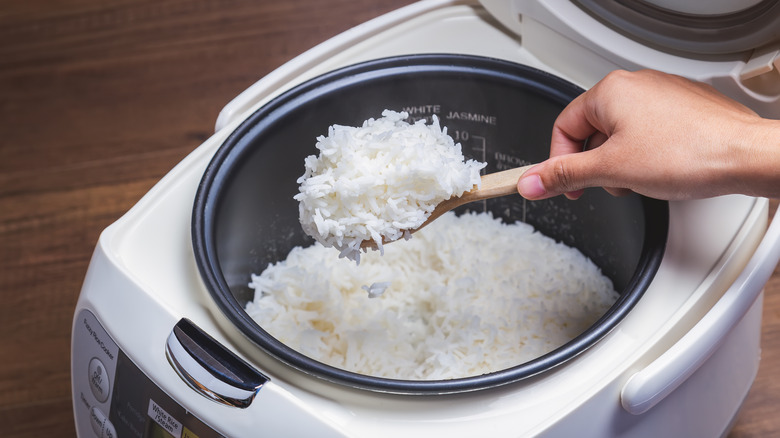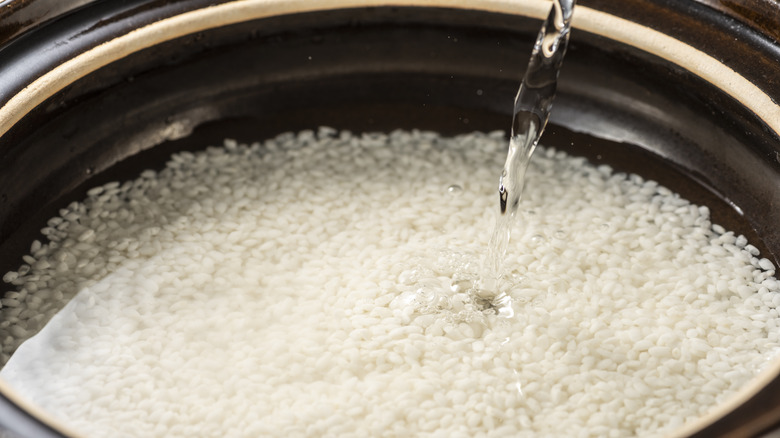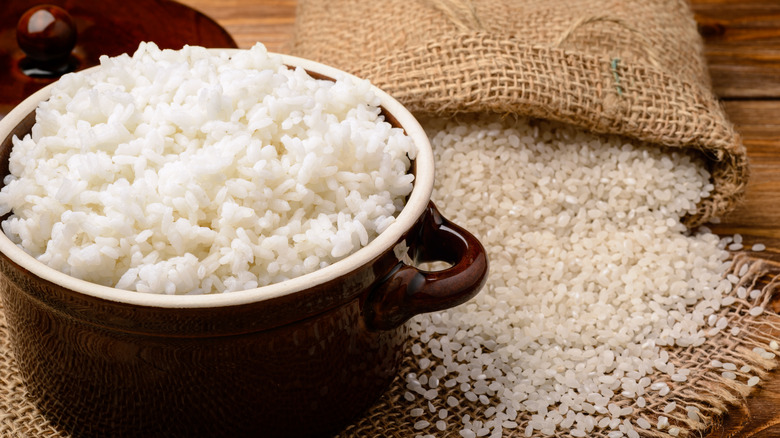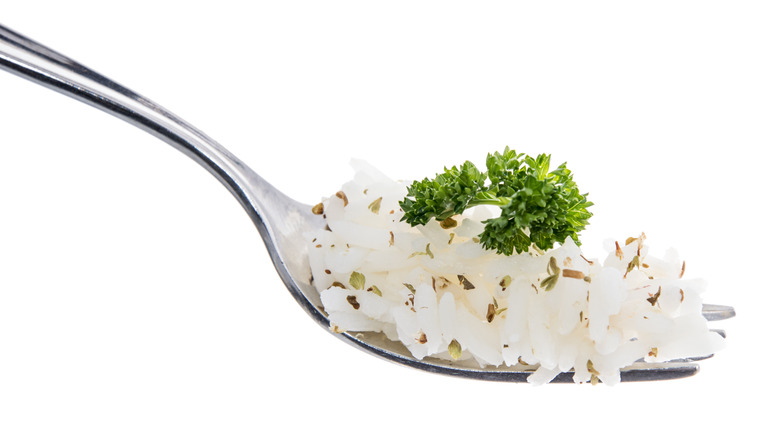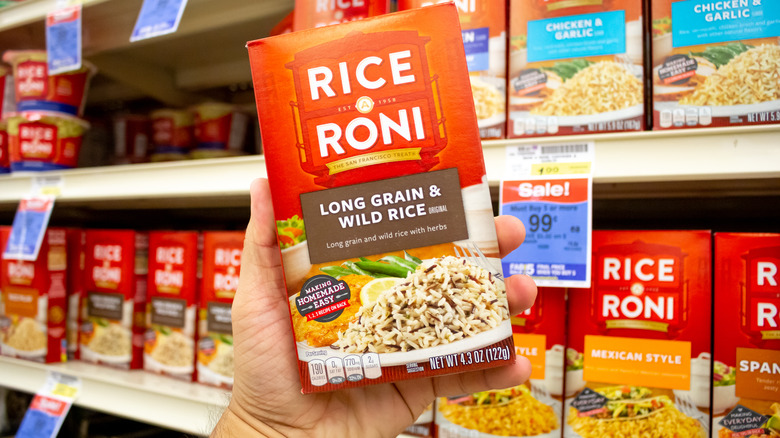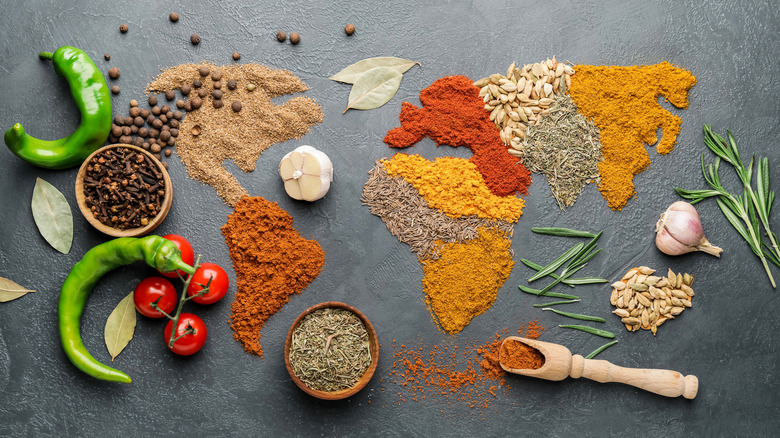12 Mistakes You're Making When Cooking Rice
It's almost a sure bet that you'd find a bag — or maybe even multiple bags — of rice if you were to open your pantry right now. After all, it's a staple in many homes. Rice can be used in a variety of recipes, including main dishes, sides, and even some desserts. Add some rice to a soup for a hearty meal, serve it on the side of your favorite Chinese food dishes, mix it with some eggs, soy sauce, and scallions to make fried rice, or just eat it plain to help ease a stomachache – the possibilities really are endless.
In addition to all of its many uses, rice — especially brown rice — can make a nutritious meal. Nourish by WebMD explains that adding brown rice to a diet can help control blood sugar for individuals with diabetes. Brown rice is also a good source of fiber, which can help you feel more satisfied after a meal to reduce snacking and stay at a healthy weight. Brown rice offers high levels of a variety of vitamins and minerals, including vitamins B1 and B6, selenium, phosphorus, and magnesium.
If you're like many, you may find it difficult to cook rice properly. Whether your rice always seems to end up too soupy, turns out hard and crispy, or gets burned on your cookware, changing a few things in your cooking routine can help ensure that every recipe turns out perfectly. Read on to learn more about some common mistakes you'll want to avoid when cooking rice.
1. Mistake: not salting the water
Salting the water is important when cooking rice. While you can technically leave the salt out, you may be sad that you did. Without salt, the rice won't be as flavorful and enjoyable. Another mistake people make related to using salt when cooking rice is not using the right amount. The ideal amount of salt will depend on how much rice you're cooking and how much water is in the pot. As a general rule, add about 1 teaspoon of salt for each 2 cups of water (which would mean that you're cooking about 1 cup of rice). However, this isn't a hard and fast ratio. Some types of rice may require a little more or less salt, depending on how quickly they cook. For faster-cooking rice varieties, you can slightly cut back on the amount of salt you add to the water, while you may want to add just a little more salt to the water when you're making a slower-cooking long-grain rice.
Remember that it's important to add the salt to the water before you add the rice. If you don't add it until after the rice is cooked, or mostly cooked, the rice will taste overly salty. Rice that is too salty can really ruin a meal.
2. Mistake: not rinsing the rice
When you cook rice, do you rinse it first? If you just answered "no" to that question, you may want to change your cooking practices. Rinsing rice before cooking it can help it turn out better. When you so do, it takes off some of the starch on the surface, which can help ensure that the cooked rice comes out nice and fluffy, rather than as a clumped and sticky mess.
In addition to helping it turn out fluffier and more delicious, rinsing rice can also make sure that it's clean before you cook it. Just as you should rinse your fruits and vegetables before eating or cooking with them, the same is true for rice. Rinsing it will get rid of chemicals, dust, and any other debris that may be coating each grain or mixed in with the bag.
Now that you know why you should rinse rice, let's take just a second to learn how to do so. First, measure out the appropriate amount of rice for your recipe. Then, put it in a colander or mesh strainer and place it under running water for 30 seconds to a minute. As the water is running over the rice, shake the colander a few times to move the rice around and make sure the water runs over each grain. Once the rice has been rinsed, shake the colander again to remove any excess water and move the rice to the vessel you'll be using to cook it.
3. Mistake: not using the correct amount of water
One of the biggest mistakes you can make when cooking brown rice, white rice, or any other variation is not using the right amount of water. All rice expands when you cook it. Each grain is dehydrated before being packaged. Cooking in hot water rehydrates the rice, making it expand and fluff up. However, the exact amount of expansion will vary among different types of rice.
Understanding how much each rice variety expands can help you make sure that you add enough water to the pot to allow the rice to expand the full amount so that it ends up soft and fluffy, instead of hard and crunchy. Similarly, it will also prevent you from adding so much water that your cooked rice ends up soupy and mushy. As a general rule, go with 2 cups of water for each 1 cup of short-grain rice and 1¾ cups of water for each 1 cup of long-grain rice.
4. Mistake: not choosing the right type of rice for each meal
There are several types of rice, each with its own set of characteristics that can make it a better fit for different recipes. Each of the different variations of rice can fall into one of two main categories: long-grain rice and medium- to short-grain rice. While long-grain rice has a fluffier texture, short-grain rice is stickier. Another key difference between these two categories is the way the rice expands when it cooks. Long-grain rice expands to become longer. Conversely, medium- and short-grain rice varieties expand outward and get rounder, which is why they stick to one another as they cook.
A few popular long-grain rice types include basmati rice (ideal for Mediterranean, Nepalese, and Indian dishes), Carolina Gold rice (tasty when used with porridge to make low-country meals), and jasmine rice (perfect for fried rice, stir-fry meals, and curry dishes). Popular short- and medium-grain rice varieties include arborio rice (great for risotto and soupier meals), black rice (ideal for making salads and sweet and sticky rice), and red rice (optimal for gumbo and salads).
5. Mistake: cooking rice without a lid
You cook pasta with the lid off; shouldn't you do the same when cooking rice? Absolutely not. It is important to cover the pot when you're making rice. It is best to leave the lid off while you bring the pot of rice, water, and salt to a boil. After it starts boiling, you'll want to put the lid on top of the pot if you want your rice to turn out right.
Covering a pot of cooking rice helps prevent moisture and steam from escaping. If too much water boils out of the pot, as it could if it isn't covered, the rice could end up too hard. Similarly, without the lid, the temperature in the different parts of the pot could vary. The bottom of the pot will be hotter than the top, which could result in the rice near the base cooking more quickly. This is one way you may end up with a burnt and stuck-on mess when cooking rice.
6. Mistake: taking the lid off while the rice is cooking
Taking the lid off while rice is cooking is another big no-no you'll want to avoid. Some people are tempted to take the lid off to stir the rice, but doing so isn't necessary if you have followed the right ratios and other recommendations. In fact, taking the lid off — even just for a few seconds — can result in a loss of heat from the pot.
Dickson put this advice to the test and cooked two pots of rice, using a temperature probe to measure the temperature of the air above the cooking rice. For the first pot, they left the lid on the rice for the entire time. For the second pot, they took the lid off for 10 seconds at three different intervals while the rice cooked. The ambient air in the pot where the lid stayed in place remained consistently around 210 degrees Fahrenheit throughout the cooking process. However, the air temperature in the pot where the lid was removed fluctuated significantly each time it was taken off. For example, the first time the lid was taken off, the internal air temperature plummeted from 210 to 125 degrees Fahrenheit. While it did increase again once the lid was returned, it still didn't make it all the way back up to the 210 degrees that the other pot maintained throughout the process.
7. Mistake: not using a rice cooker
You certainly can cook rice on the stovetop, but is it better to use a rice cooker? A rice cooker can take much of the guesswork out of cooking rice and can help you achieve perfectly fluffy and soft grains every time. If you find yourself having trouble getting the right ratio of rice to water, finding the perfect heat setting on the stove, or judging when your pot of rice has finished cooking, a rice cooker may be worth the investment.
One benefit of using a rice cooker is that you'll be able to easily cook a variety of rice types without worrying about them burning or sticking to the pot. The rice you cook can also stay warm inside the rice cooker, eliminating the need to use a microwave to warm it up if it cools too quickly. Rice cookers are also very easy to use. All you need to do is measure out your rice and water, put them in the cooker, and choose the right cooking mode. You can also use your rice cooker for more than just cooking rice. Some recipe ideas include barbecue shrimp with cheese and bacon grits, frittatas, and banana bread.
8. Mistake: not starting with cold water
If you've been boiling the water before adding the rice to it, you may be surprised to learn that it is better to put rice in cold water and bring it all to a boil together. When you start rice in cold water, it will cook more evenly, as each grain of rice is better able to absorb the water.
Conversely, if you put the rice into an already hot pot of boiling water, it can come out unevenly cooked. The boiling water will cook the outer layer of the rice quickly, but the inside of each grain will not be able to absorb as much water and won't soften as much as it would when cooked in cold water. This can result in your rice turning out too hard and crunchy, something none of us want. On top of that, when you add rice to boiling water, it can actually take longer to cook than when you start it in cold water, which may be the opposite of what you'd think.
9. Mistake: not allowing the rice to rest before serving
When many people look in their pot and see that the water has been absorbed, they start serving the rice right away. However, this is a mistake. Letting rice rest for a few minutes after all of the water has been absorbed is a crucial step in the cooking process. If you start serving the rice immediately and don't give it this rest period, the grains are more likely to have an uneven consistency and texture, with the tops being firmer than the bottoms.
The right thing to do is to take the pot of rice off of the heat after all of the water has been absorbed. Then, briefly remove the lid to lay a clean towel over the top of the pot. Return the lid, gently pushing it down for a good seal. Leave the rice to sit like this for about 15 minutes. This will give the grains of rice sufficient time to finish absorbing enough moisture to ensure a fluffier and tastier consistency.
10. Mistake: not fluffing the rice
You've followed all the steps to properly cook your rice and let it rest, so now you're ready to serve it up, right? Wrong. Before you start dishing out the rice, there is one more key thing you'll want to do to ensure a tasty meal: Fluff it. Fluffing rice can help eliminate any clumps and free up any moisture that may be trapped between the grains.
Now, the next question is whether you should use a spoon or fork to fluff the rice. Fluffing using a spoon would be a mistake. When you use a spoon, it could make the rice too mushy by bruising it. Rather, using the tines of a fork will ensure the grains aren't stuck together, without bruising or crushing them. As you're fluffing the rice, consider adding just a little bit of coconut oil or butter if you want to give each grain a coating and a little extra flavor.
11. Mistake: cooking boxed rice
Cooking rice can be intimidating; all the same, it's time to stop using boxed rice. While it may help save some time when you have everything you'll need to cook a rice-based meal ready to go in a box, the flavor packets that come with many brands are very high in sodium. Some dish out as much as 1,350 milligrams of sodium per serving (assuming you only eat just one serving), which is already more than half of the maximum daily intake of 2,300 milligrams recommended by the Food and Drug Administration.
According to Healthline, diets high in sodium can increase the risk of developing several health conditions. These include high blood pressure, stomach cancer, and heart disease. Making your own lower-sodium sauces and seasonings and adding them to plain rice can provide you with a tasty and enjoyable meal without all the unnecessary sodium that comes with many packages of boxed rice.
12. Mistake: seasoning rice after cooking
If you want to add any seasonings to your rice, the best time to do so is before you cook it. Just as adding salt to already cooked rice can result in an overly salty and less flavorful taste, the same is true when using other seasonings and spices. However, if you add them to the water before the rice cooks, their flavor will be more evenly distributed through each grain, resulting in a more enjoyable meal or side dish.
Depending on the dish you are cooking and your desired flavor, there are many different seasonings you can add to rice. These include saffron, garlic powder, thyme, red pepper flakes, oregano, paprika, and onion powder. You can also consider cooking rice in coconut milk, beef broth, or chicken broth, water with lemon juice, tomato juice, or carrot juice for a more unique and enjoyable flavor.
